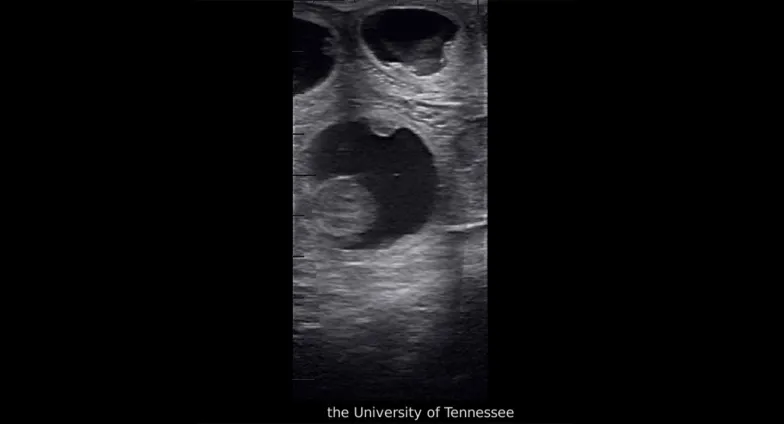Options for Pregnancy Diagnosis in Beef Cattle
The profitability of any business is crucial, and livestock production is no different. With most revenue originating from the sale of calves produced, retaining non-pregnant cows in a cow-calf operation is hard to justify. Therefore, the fall of the year is traditionally pregnancy detection season. Cattle producers typically remove bulls from their spring-calving cow herds in late summer or early fall, bookending another breeding season, and will need to identify which cows will calve next year before winter feed resources are allocated. It is recommended that ranchers compare several pregnancy detection options to determine the best fit for their herd management program, as each option has unique benefits and disadvantages. Factors include cost, timing, training required and completeness of the information gained.
Expense
Cost is the first consideration for many producers when deciding the best way to diagnose pregnancy in their herds. It is recommended that producers assess cost along with accuracy, result timeline, and completeness of the method used. For example, monitoring estrus behavior in the herd after breeding is very affordable; however, this method carries considerable opportunity cost. Observing cattle for estrus behavior is time-consuming and potentially inaccurate due to the individuality of estrous cycles and the impacts of nutrition, lactation and environment on cyclicity in cattle. Additionally, with the detection of estrus, the result is simple: pregnant or open. This method provides no other valuable information regarding fetal age or sex. On the other hand, techniques such as transrectal palpation or ultrasound are more comprehensive, but more expensive.
Timing
Pregnancy detection requires logistical planning as cows may be on summer pasture without handling facilities, or the area veterinarian may have limited availability, among other considerations. Specific methods may align better with the production timeline. For instance, transrectal ultrasound and blood antigen tests can diagnose pregnancy as soon as 28 days after the last possible breeding date, whereas diagnosing pregnancy by transrectal palpation requires a little more time (typically around 40 or more days after breeding). While blood antigen tests are accurate early in gestation, they do not give an immediate result, as it takes time to run the samples. Thus, cattle must be resorted after performing the test, which can be a deterrent due to labor demands. If feed resources or cattle handling facilities are limiting factors, it is important to know when each pregnancy detection method can be performed. Retaining and feeding cows is costly, and opting for earlier detection is often beneficial so that open cows can be marketed earlier.
Training
Each pregnancy detection method requires varying levels of training or expertise. This is important to consider as trained professionals are often few and far between in many remote areas devoted to cattle production. The detection of estrus and blood antigen tests both require very minimal, if any, training. They are accomplished by visual observation or simply drawing a blood sample. Both methods can be very convenient options for operations that may not have access to trained professionals. As a trade-off, these methods are not as comprehensive as those requiring more extensive training. Ranchers should consider how the timeline and expense of these methods may fit into their management plan.
Completeness
Observing for estrus behavior and testing for pregnancy-specific factors with a blood antigen test are the least comprehensive methods of pregnancy detection. There is little reliable information for producers to gain aside from whether a female is pregnant or open. In some operations, that may be all that is necessary; however, in others, it is essential to know if cattle are carrying a calf sired by artificial insemination or natural service, the predicted calving date, or whether to expect a bull or heifer calf at calving. Rectal palpation or ultrasound are the most comprehensive options for answering these questions.
Fetal age is valuable information. In operations utilizing synchronization and fixed-time artificial insemination, it is common for natural service sires to be introduced to the cow herd around 10 days after artificial insemination. In this case, distinguishing pregnancies by artificial insemination from natural service is simple with palpation or ultrasound. Determining an accurate fetal age can also be helpful for producers to concentrate labor during their calving season and identify females that conceived late in the breeding season as potential cull animals. In these situations, a more accurate fetal age determined by palpation or ultrasound is necessary. Information that can only be determined by ultrasound are fetal heartbeat and fetal sex. If early embryonic loss (no detection of fetal heartbeat) is in question, or females need to be sorted by those carrying bull or heifer calves, ultrasound is the only option.
Every operation that raises beef cattle can benefit from pregnancy diagnosis; however, the method used can vary from herd to herd. To find the most cost-effective method for your operation, consider how soon after breeding you need to detect pregnancy, the labor required, the availability of trained professionals, and the information you need to gain for your management system.
| Cost per Cow | Labor Demand | Days Post-breeding | Training / Equipment | Fetal Age | Fetal Sex | Advantage | Disadvantage | |
| Detection of Estrus | $0 | High | ~18+ | Minimal | No | No | Affordable | Labor, Limited accuracy |
| Palpation | $3 to $10 | Low | 40+ | Yes | Yes | No | No equipment needed | Experience needed |
| Ultrasound | $6 to $15 | Low | 28+ | Yes | Yes | Yes | Most comprehensive | Expense, Experience needed |
| Blood Test | $3 to $18 | Moderate | 28+ | Minimal | No | No | No training needed | Not immediate, need to re-sort |
